PEP新版五年级英语上册Unit1复习完美版
- 格式:ppt
- 大小:678.00 KB
- 文档页数:9

人教版PEP小学英语五年级上册Unit1名师视频讲解+课文单词音频+知识点梳理+单元练习Unit 1 What's he like?同步课堂视频讲解*本视频来源于网络,仅供学习参考▲点右上方绿标即可收听old [əuld] 老的;年纪大的young [jʌŋ] 年轻的;岁数不大的funny ['fʌni] 滑稽的;可笑的kind [kaInd] 体贴的;慈祥的;宽容的strict [strIkt] 要求严格的;严厉的polite [pə'laɪt]有礼貌的;客气的hard-working [ˈhɑːdˈwɜːkɪŋ]工作努力的;辛勤的helpful ['helpfl]有用的;愿意帮忙的clever ['klevə(r)]聪明的;聪颖的shy [ʃaɪ]羞怯的;腼腆的;怕生的know [nəu] 知道;了解our [‘aʊə]我们的Ms [mIz](用于女子的形式或姓名前,不指明婚否)女士will [wɪl](谈及将来)将要sometime ['sʌmtaɪmz]有时;间或robot ['rəʊbɒt]机器人him [hɪm](用作宾语或表语)他speak [spiːk] 会说;会讲(某种语言)说话finish ['fɪnɪʃ]完成;做好Unit 1 知识点梳理五年级英语(上)PEP版Unit 1 What's he like?重点:询问某人的外貌特征或性格特点的句型连词but和and的用法情态动词can的用法难点:询问他人的外貌特征或性格特点人称代词、物主代词、be动词的用法四会单词短语old老的;年纪大的young年轻的;岁数不大的funny滑稻的;可笑的kind体贴的;慈祥的;宽容的strict要求严格的;严厉的polite有礼貌的;客气的hard-working工作努力的;辛勤的helpful有用的;愿意帮忙的clever聪明的;聪颖的shy羞怯的;腼腆的;怕生的三会单词短语know知道;了解our我们的Ms(用于女子的姓氏或姓名前,不指明婚否)女士wiII(谈及将来)将要sometimes有时;间或robot机器人him(用作宾语或表语)他speak会说;会讲(某种语言);用(某种语言)说finish完成;做好headteacher校长music teacher音乐老师惯用表达式Great!太棒了!Really?真的吗?Cool!酷!重点句式或句型1.-Who' s your art teacher?谁是你的美术老师?-Mr Jones.琼斯老师。
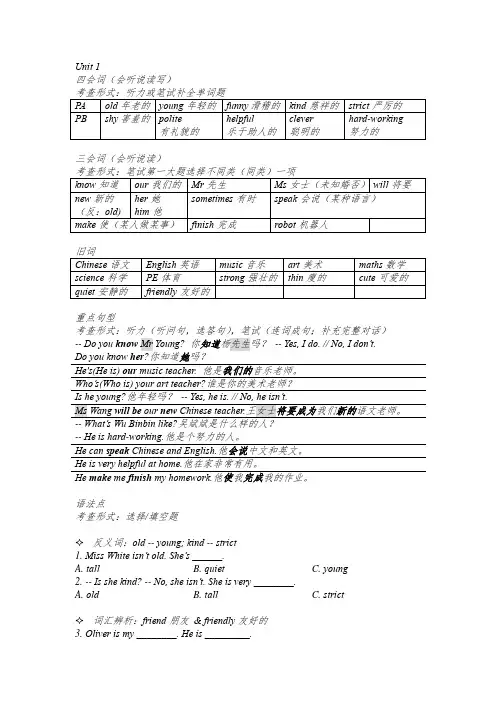
Unit 1四会词(会听说读写)三会词(会听说读)重点句型考查形式:听力(听问句,选答句),笔试(连词成句;补充完整对话)-- Do you know Mr Young? 你知道杨先生吗?-- Yes, I do. // No, I don’t. Do you know her?你知道她吗?He's(He is) our music teacher. 他是我们的音乐老师。
Who’s(Who is) your art teacher?谁是你的美术老师?-- He is hard-working.他是个努力的人。
He can speak Chinese and English.他会说中文和英文。
He is very helpful at home.他在家非常有用。
He make me finish my homework.他使我完成我的作业。
语法点考查形式:选择/填空题✧反义词:old -- young; kind -- strict1.Miss White isn’t old. She’s ______.A.tallB.quietC.young2.-- Is she kind? -- No, she isn’t. She is very ________.A.oldB.tallC.strict✧词汇辨析:friend朋友& friendly友好的3.Oliver is my ________. He is _________.A.friend; friendB.friendly; friendlyC.friend; friendly✧Who? 谁?(who is 缩写:who’s)4.-- ____ is Mr Black? -- He’s our EnglishA.WhereB.WhoC.Who’s5.-- ____ your art teacher? -- Miss Li.A.WhoB.Who’sC.Whose✧-- Is he / she...? -- Yes, he / she is. // No, he / she isn’t.✧Mr先生;Ms女士(Mrs夫人[已婚]; Miss小姐[未婚])6.-- Is Mrs Young very young? -- _____ Mrs Young is 52 years old.A.Yes, she is.B.No, he isn’tC.No, she isn’t.7.Is Mr Black young? -- ____________A.Yes, he is.B.Yes, she is.C.No, I’m not.✧问外貌/ 性格的句型:What’s +某人+ like?8.-- What’s Ms Wang like? -- _______A.She’s kind.B.She likes music.C.He’s tall.9.-- What’s Tom like? -- __________A.He’s 12.B.He’s clever.C.She’s clever.✧-- Do you...? -- Yes, I do. // No, I don’t.✧her她/ him他(一般在动作词语的后面)& she / he(主语,一般在句首)10.-- Do you know ____? -- Yes, I ___A.she; doB.her; amC.her; do11.-- Do you like funny teacher? -- __________A.Yes, I like.B.Yes, I do.C.Yes, we are.12.Who’s that woman? Do you know ______.A.heB.herC.him✧and和& but但是(转折,前后意思相反)13.Ms Wang is kind. ______ sometimes she is strict.A.andB.AndC.but14.Lu Yao is clever ____ helpful.A.andB.orC.but✧I +am& he / she /一个人+ is& we / you / they /两个以上的人+ are15.John and Wu Binbin ____ hard-working.A.isB.amC.are16.Mr Ma _____ very funny.17.-- _____ you quiet? -- Yes, I _____.。
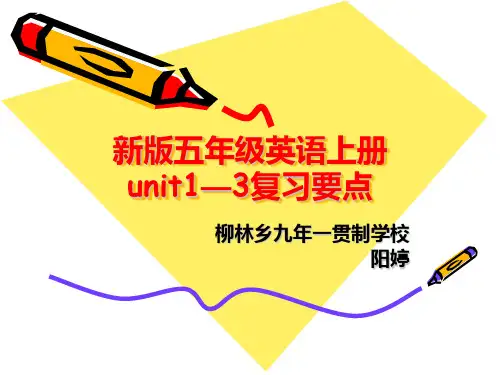
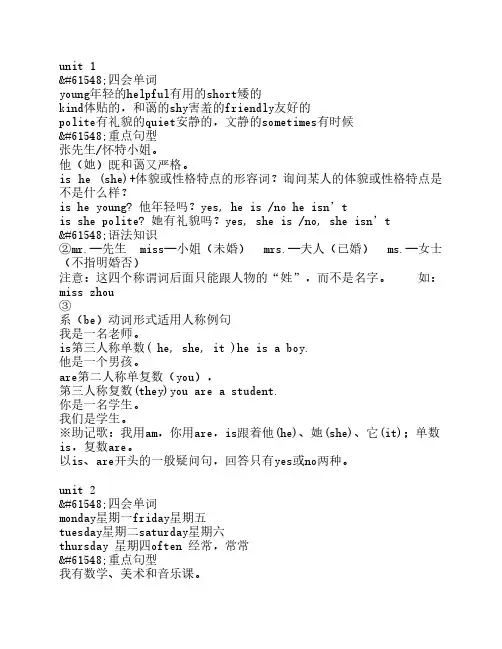
unit 1四会单词young年轻的helpful有用的short矮的kind体贴的,和蔼的shy害羞的friendly友好的polite有礼貌的quiet安静的,文静的sometimes有时候重点句型张先生/怀特小姐。
他(她)既和蔼又严格。
is he (she)+体貌或性格特点的形容词?询问某人的体貌或性格特点是不是什么样?is he young? 他年轻吗?yes, he is /no he isn’tis she polite? 她有礼貌吗?yes, she is /no, she isn’t语法知识②mr.—先生 miss—小姐(未婚) mrs.—夫人(已婚) ms.—女士(不指明婚否)注意:这四个称谓词后面只能跟人物的“姓”,而不是名字。
如:miss zhou③系(be)动词形式适用人称例句我是一名老师。
is第三人称单数( he, she, it )he is a boy.他是一个男孩。
are第二人称单复数(you),第三人称复数(they)you are a student.你是一名学生。
我们是学生。
※助记歌:我用am,你用are,is跟着他(he)、她(she)、它(it);单数is,复数are。
以is、are开头的一般疑问句,回答只有yes或no两种。
unit 2四会单词monday星期一friday星期五tuesday星期二saturday星期六thursday 星期四often 经常,常常重点句型我有数学、美术和音乐课。
i often read books.星期四你做什么?我和我的爸爸看电视。
你呢?我经常读书。
do you often play football?肯定回答:yes, i do.否定回答:no, i don’t.你经常踢足球吗?是的,我经常踢。
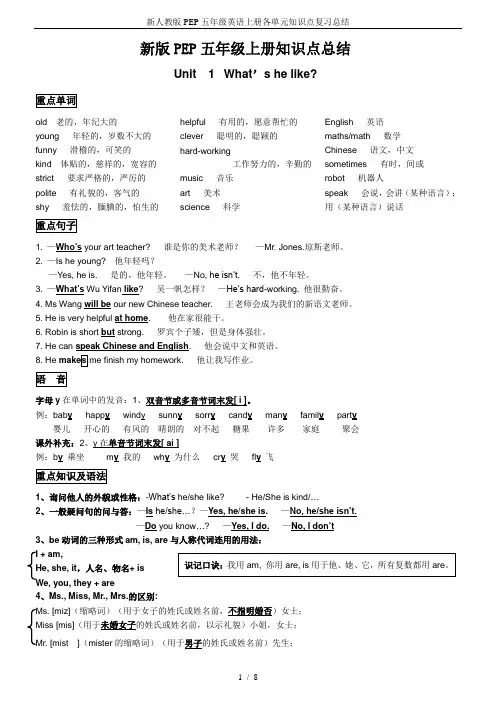
新人教版PEP五年级英语上册各单元知识点复习总结新版PEP五年级上册知识点总结Unit 1 What’s he like?重点单词old 老的,年纪大的young 年轻的,岁数不大的funny 滑稽的,可笑的kind 体贴的,慈祥的,宽容的strict 要求严格的,严厉的polite 有礼貌的,客气的shy 羞怯的,腼腆的,怕生的helpful 有用的,愿意帮忙的clever 聪明的,聪颖的hard-working工作努力的,辛勤的music 音乐art 美术science 科学English 英语maths/math 数学Chinese 语文,中文sometimes 有时,间或robot 机器人speak 会说,会讲(某种语言);用(某种语言)说话重点句子1. —Who’s your art teacher? 谁是你的美术老师?—Mr. Jones.琼斯老师。
2. —Is he young? 他年轻吗?—Yes, he is. 是的,他年轻。
—No, he isn’t.不,他不年轻。
3. —What’s Wu Yifan like? 吴一帆怎样?—He’s hard-working. 他很勤奋。
4. Ms Wang will be our new Chinese teacher. 王老师会成为我们的新语文老师。
5. He is very helpful at home. 他在家很能干。
6. Robin is short but strong. 罗宾个子矮,但是身体强壮。
7. He can speak Chinese and English. 他会说中文和英语。
8. He makes me finish my homework. 他让我写作业。
语音字母y在单词中的发音:1、双音节或多音节词末发[ i ]。
例:bab y happ y windy sunn y sorr y cand y man y famil y part y婴儿开心的有风的晴朗的对不起糖果许多家庭聚会课外补充:2、y在单音节词末发[ ai ]例:b y 乘坐m y 我的wh y 为什么cr y 哭fl y 飞重点知识及语法1、询问他人的外貌或性格:-What’s he/she like? - He/She is kind/…2、一般疑问句的问与答:—Is he/she…?—Yes, he/she is.—No, he/she isn’t.—Do you know…? —Yes, I do.—No, I don’t3、be动词的三种形式am, is, are与人称代词连用的用法:I + am,He, she, it,人名、物名+ isWe, you, they + are4、Ms., Miss, Mr., Mrs.的区别:Ms. [miz](缩略词)(用于女子的姓氏或姓名前,不指明婚否)女士;Miss [mis](用于未婚女子的姓氏或姓名前,以示礼貌)小姐,女士;Mr. [mist](mister的缩略词)(用于男子的姓氏或姓名前)先生;识记口诀:我用am, 你用are, is用于他、她、它,所有复数都用are。

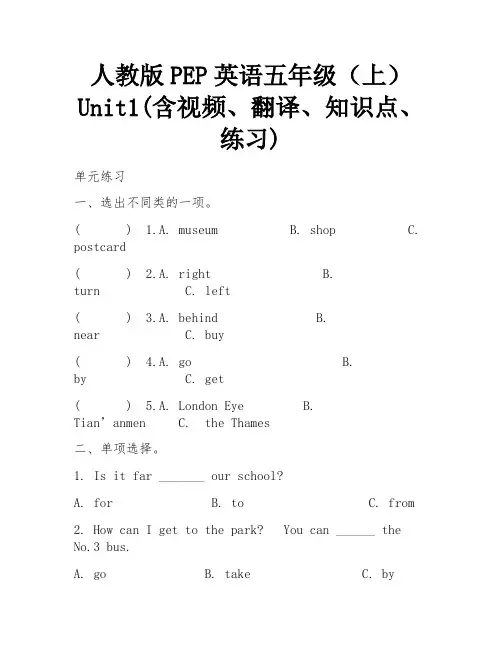
人教版PEP英语五年级(上)Unit1(含视频、翻译、知识点、练习)单元练习一、选出不同类的一项。
( ) 1.A. museum B. shop C. postcard( ) 2.A. right B.turn C. left( ) 3.A. behind B.near C. buy( ) 4.A. go B.by C. get( ) 5.A. London Eye B.Tian’anmen C. the Thames二、单项选择。
1. Is it far _______ our school?A. forB. toC. from2. How can I get to the park? You can ______ the No.3 bus.A. goB. takeC. by3. It’s not far. It’s _______A. nearB. longC. far4. _________ , Is there a hospital near here?A.SorryB.Hello C. Excuse me5. _______ is the library?A.What B. Where C .How6. Turn left _______ the bookstore. It’s ______ the left.A. at, atB. on, onC. at, on7. Is there a cinema near here?A. Yes, it is.B. Yes, there isC. No, it isn’t.8. How can I get to the school?A. You can go by bike.B. You are hereC. It’s not far三、连词成句。
1. left, the, post, at, turn, office (.)_______________________________________2. get, can, I, museum, to, the, how, science (?) _________________________________________________3. far, is, it, here, from (?)_________________________________________________ 4. next, the, It’s, museum, to(.)_________________________________________________5. is, a, city, in, my, there, hospital, pet (.) _________________________________________________四、为下列句子选择最佳答语。
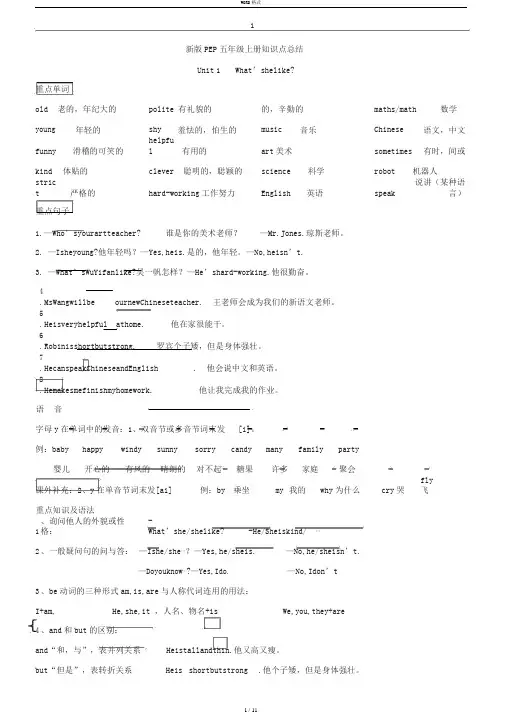
1新版PEP五年级上册知识点总结Unit 1 What’shelike?重点单词old 老的,年纪大的polite 有礼貌的的,辛勤的maths/math 数学young年轻的shy 羞怯的,怕生的music 音乐Chinese 语文,中文funny 滑稽的可笑的helpful 有用的art美术sometimes 有时,间或kind 体贴的clever 聪明的,聪颖的science 科学robot 机器人strict 严格的hard-working工作努力English 英语speak 说讲(某种语言)重点句子1.—Who’s yourartteacher? 谁是你的美术老师?—Mr.Jones.琼斯老师。
2.—Isheyoung?他年轻吗?—Yes,heis.是的,他年轻。
—No,heisn’t.3.—What’s WuYifanlike?吴一帆怎样?—He’shard-working.他很勤奋。
4.MsWangwillbe ournewChineseteacher. 王老师会成为我们的新语文老师。
5.Heisveryhelpful athome. 他在家很能干。
6.Robinisshortbutstrong. 罗宾个子矮,但是身体强壮。
7.HecanspeakChineseandEnglish . 他会说中文和英语。
8.Hemakesmefinishmyhomework. 他让我完成我的作业。
语音字母y在单词中的发音:1、双音节或多音节词末发[i]。
例:baby happy windy sunny sorry candy many family party 婴儿开心的有风的晴朗的对不起糖果许多家庭聚会课外补充:2、y在单音节词末发[ai] 例:by 乘坐my我的why为什么cry哭fly 飞重点知识及语法1、询问他人的外貌或性格:-What’s he/shelike? -He/Sheiskind/⋯2、一般疑问句的问与答:—Ishe/she⋯?—Yes,he/sheis. —No,he/sheisn’t.—Doyouknow⋯?—Yes,Ido.—No,Idon’t3、be动词的三种形式am,is,are与人称代词连用的用法:I+am, He,she,it ,人名、物名+is We,you,they+are4、and和but的区别:and“和,与”,表并列关系Heistallandthin.他又高又瘦。
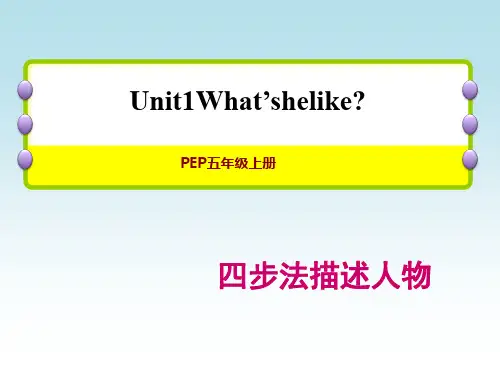
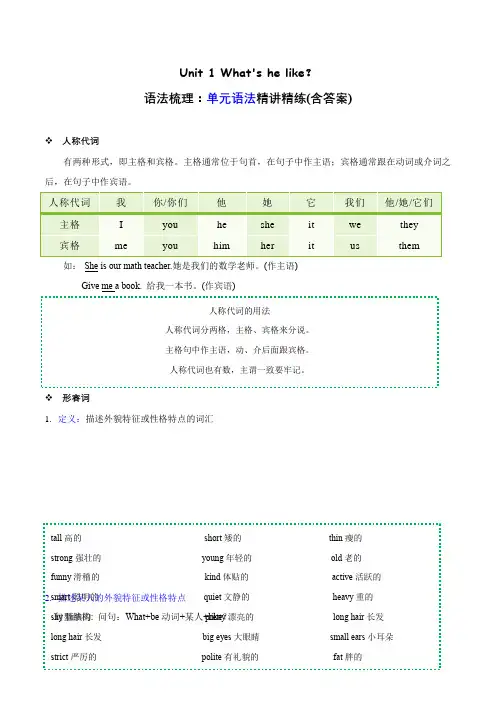
Unit 1 What's he like ?语法梳理:单元语法精讲精练(含答案)❖ 人称代词有两种形式,即主格和宾格。
主格通常位于句首,在句子中作主语;宾格通常跟在动词或介词之后,在句子中作宾语。
如:-She is our math teacher.她是我们的数学老师。
(作主语)Give me a book. 给我一本书。
(作宾语)❖ 形容词1. 定义:描述外貌特征或性格特点的词汇2. 描述某人的外貌特征或性格特点句型结构: 问句:What+be 动词+某人+like ? 人称代词的用法人称代词分两格,主格、宾格来分说。
主格句中作主语,动、介后面跟宾格。
人称代词也有数,主谓一致要牢记。
tall 高的 short 矮的 thin 瘦的 strong 强壮的 young 年轻的 old 老的 funny 滑稽的 kind 体贴的 active 活跃的smart 聪明的 quiet 文静的 heavy 重的 shy 腼腆的 pretty 漂亮的 long hair 长发 long hair 长发 big eyes 大眼睛 small ears 小耳朵 strict 严厉的 polite 有礼貌的 fat 胖的答语:主语+be动词+描述外貌特征或性格特点的形容词.如: —What's he like? 他什么样?—He is tall and strong. 他又高又强壮。
3.描述他人体貌特征的其他方式句型结构: 主语+ have/has (a/an) + 形容词+ 名词。
如:My sister has long hair. 我姐姐留着长发。
❖一般现在时的一疑问句★★★★★1.定义:一般疑问句通常以be动词、助动词或情态词开头,回答时用yes或no。
现在我们一起来看一下一般现在时的一般疑问句的基本句型吧。
(1)含有实义动词的肯定句变一般疑问句时,要在句首加助动词do/does,谓词用原形。
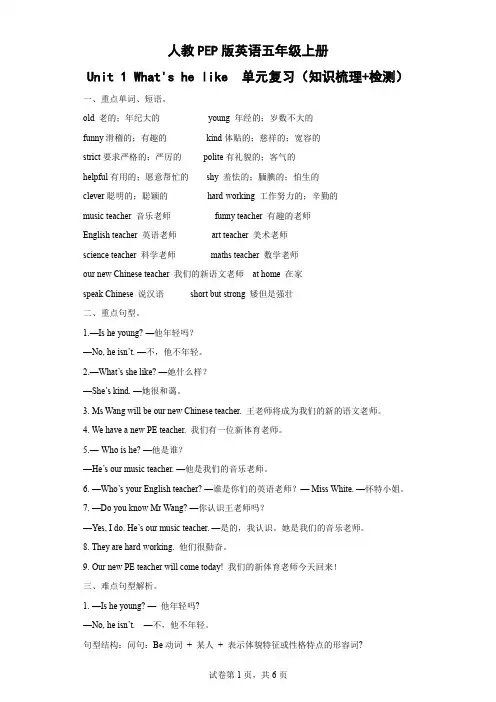
人教PEP版英语五年级上册Unit 1 What's he like 单元复习(知识梳理+检测)一、重点单词、短语。
old 老的;年纪大的young 年经的;岁数不大的funny滑稽的;有趣的kind体贴的;慈祥的;宽容的strict要求严格的;严厉的polite有礼貌的;客气的helpful有用的;愿意帮忙的shy 羞怯的;腼腆的;怕生的clever聪明的;聪颖的hard-working 工作努力的;辛勤的music teacher 音乐老师funny teacher 有趣的老师English teacher 英语老师art teacher 美术老师science teacher 科学老师maths teacher 数学老师our new Chinese teacher 我们的新语文老师at home 在家speak Chinese 说汉语short but strong 矮但是强壮二、重点句型。
1.—Is he young? —他年轻吗?—No, he isn’t. —不,他不年轻。
2.—What’s she like? —她什么样?—She’s kind. —她很和蔼。
3. Ms Wang will be our new Chinese teacher. 王老师将成为我们的新的语文老师。
4. We have a new PE teacher. 我们有一位新体育老师。
5.—-Who is he? —他是谁?—He’s our music teacher. —他是我们的音乐老师。
6. —Who’s your English teacher? —谁是你们的英语老师?— Miss White. —怀特小姐。
7. —Do you know Mr Wang? —你认识王老师吗?—Yes, I do. He’s our music teacher. —是的,我认识。
她是我们的音乐老师。
8. They are hard-working. 他们很勤奋。
新版PEP五年级英语上册Unit 1-2知识点总结 -(姓名:_____ 班级:______)黑体的单词和句子要求听、说、读、写.其他部分的内容要达到熟读.Unit 1重点单词新版PEP五年级英语上册Unit 1-2知识点总结 -young 年轻的;岁数不大的funny 滑稽的;可笑的kind体贴的;慈祥的;宽容的strict 要求严格的;严厉的polite 有礼貌的;客气的shy 羞怯的;腼腆的;怕生helpful有用的;愿意帮忙的clever 聪明的;聪颖的hard-working工作努力的;辛勤的music 音乐art 美术science 科学English 英语maths/math 数学Chinese 语文;中文sometimes 有时;间或robot 机器人speak会说;会讲(某种语言);用(某种语言)说话新版PEP五年级英语上册Unit 1-2知识点总结 -1. —Who’s your art teacher? 谁是你的美术老师?—Mr. Jones.琼斯老师.2. —Is he young? 他年轻吗?—Yes, he is. 是的;他年轻. —No, he isn’t. 不;他不年轻.3. —What’s she like? 她怎样?—She’s kind. 他很和蔼.4. Ms Wang will be our new Chinese teacher. 王老师会成为我们的新语文老师.5. He is very helpful at home. 他在家很能干.6. Robin is short but strong. 罗宾个子矮;但是身体强壮.7. He can s peak Chinese and English. 他会说中文和英语.8. He makes me finish my homework. 他让我写作业.语音字母y在单词中的发音:1、双音节或多音节词末发[ i ].例:baby happ y windy sunny sorry candy many family party 婴儿开心的有风的晴朗的对不起糖果许多家庭聚会课外补充:2、y在单音节词末发[ ai ]例:by 乘坐my 我的why 为什么cry 哭fl y 飞重点知识及语法1、询问他人的外貌或性格:-What’s he/she like? - He/She is kind/…2、一般疑问句的问与答:—Is he/she…?—Yes, he/she is.—No, he/she isn’t.—Do you know…? —Yes, I do.—No, I don’t3、be动词的三种形式am, is, are与人称代词连用的用法:I + am,识记口诀:我用am, 你用are, is用于他、她、它;所有复数都用are.He, she, it;人名、物名+ isWe, you, they + are4、Ms., Miss, Mr., Mrs.的区别:Ms. [miz](缩略词)(用于女子的姓氏或姓名前;不指明婚否)女士;Miss [mis](用于未婚女子的姓氏或姓名前;以示礼貌)小姐;女士;Mr. [mist](mister的缩略词)(用于男子的姓氏或姓名前)先生;Mrs. [misiz](用于已婚女子的姓氏或姓名前)太太;夫人.5、and和but的区别:and “和;与”;表并列关系He is tall and thin. 他又高又瘦.but “但是”;表转折关系He is short but strong. 他个子矮;但是身体强壮.重点作文1、介绍自己、朋友或老师等熟悉的人物;如:My …teacher/friend/….思路导引(1)开头:交代人物的身份I have a/an…He/She is…He/She has …hair/eyes…(2)中间:1)体貌He/ She is tall/strong… 2)性格He/She is strict/kind…3)爱好 He/She likes playing pingi-pong/… 或He/She often read books/… on the weekend.(3)结尾:评价人物或抒发对人物的情感I like him/her very much.2、范文:(1)课本P9 Read and write(2)My Chinese teacherI have a new Chinese teacher. She is Ms. Chen. She is tall and thin. She has big eyes and long black hair. She is kind and funny. Sometimes she is strict, too. She is hard-working. She likes reading. Her class is so much fun. We all like her.Unit 2 重点单词新版PEP五年级英语上册Unit 1-2知识点总结 -Monday (Mon.) 周一Tuesday (Tues.) 周二Wednesday (Wed.) 周三Thursday (Thurs.) 周四Friday (Fri.) 周五Saturday (Sat.) 周六weekend 周末(周六、日)wash my clothes 洗衣服watch TV 看电视do homework 做作业read books 看书play football 踢足球on the weekend 在周末play sports/do sports做体育运动listen to music 听音乐play ping-pong 打乒乓球新版PEP五年级英语上册Unit 1-2知识点总结 -1. —What do you have on Thursdays? 星期四你们上什么课?—I have math, English and music. 我们上数学、英语和音乐课.2. —What do you do on Thursdays, Grandpa? 爷爷;星期四你要做什么?—I have a cooking class with your grandma. 我和你奶奶去上烹饪课.3. —Do you often read books in this park? 你经常在这个公园看书吗?—Yes, I do. 是的—No, I don’t.不是4. Look at my picture. 看我的图片.5. You look tired. 你看起来很累.6. You should play sports every day. 你应该每天做运动.语音字母组合ee, ea在单词中的的发音:[ i: ]例:fee t bee f mee t see fee d tea read eat repea t脚牛肉遇见看见喂养茶阅读吃重复注:1、ee组合绝大部分发长音[ i: ];只有少部分发短音[ i ];如:coffee 咖啡2、ea字母组合除了发[ i: ];还有可能发[ e ]等发音;如:bread 面包;或者发[ ei ];如:great 好极了重点知识及语法1、询问做什么事/活动:—What do you do …? —I often play ping-pong…询问星期几上什么课:—What do you have on…? —We have English c lass…2、一般疑问句的问与答:—Do you often read books? —Yes, I do. —No, I don’t.3、on+具体某一天(年月日;星期);如:on Monday/Tuesday…课外at+具体时刻(…点钟);如:at12 o’clock 在十二点整补充:in+大致时间(年月;早中晚);如:in2014 在2014年in the morning/afternoon/evening4、play + 球类、棋类、娱乐活动;如:play football/ping-pong补充:play + the + 乐器(第四单元知识);如:play the pipa/piano/violin… 重点作文1、描写一周的生活;如:My week思路导引(1)开头:简单的自我介绍:My name’s…/ I’m… (2)中间:1)介绍周一至周五的情况;可以着重介绍自己最喜欢的那一天:because I have…I go to school from Monday to Friday. I like…2)介绍自己周六、日的活动:I often watch TV/…on the weekend.(3)结尾:This is my week. What about yours?2、范文:My weekMy name is Li Ming. I go to school from Monday to Friday. I like Tuesdays and Thursdays, because I have music and PE. I often do my homework and read books on Saturdays. I often play ping-pong on Sundays.Unit 3重点单词新版PEP五年级英语上册Unit 1-2知识点总结 -hamburger 汉堡包tea 茶sandwich 三文治salad 沙拉fresh 新鲜的;刚摘的healthy 健康的delicious 美味的;可口的hot 辣的;辛辣的sweet 含糖的;甜的hungry 饿的thirsty 渴的;口渴的favourite 特别喜爱的food 食物drink 喝;饮carrot 胡萝卜chicken 鸡肉onion 洋葱milk 牛奶bread 面包beef noodles 牛肉面fish sandwich 鱼肉三明治tomato soup 西红柿汤新版PEP五年级英语上册Unit 1-2知识点总结 -1.—What would you like to eat? 你想吃什么?—A sandwich, please. 请给我一个三明治.—What would you like to drink? 你想喝什么?—I’d like some water. 我想喝点水.2. —What’s your favourite food?你最喜欢吃什么食物?—Noodles. They are delicious. 面条.面条很好吃.3. My/His /Her favourite food is fish. 我/他/她最喜欢的食物是鱼.4. I’m hungry/thirsty. 我饿/渴了.5. I don’t like beef but chicken is OK. 我不喜欢牛肉但是鸡肉也可以.6. Onions are my favourite vegetable. 洋葱是我最喜欢的蔬菜.7. I like vegetables but not carrots. 我喜欢吃蔬菜但不喜欢胡萝卜.语音字母组合ow在单词中的发音:[ au ] ;[例:[ au ] cow奶牛flow er 花wow哇dow n 向下how如何;怎样now现在[slow慢的snow雪yellow黄色window窗户snow y 下雪的tomorrow明天重点知识及语法1、询问想要吃/喝什么:—What would you like to eat/drink? —I’d like…2、询问最喜欢的事物:—What’s your favourite food/vegetable/…? —My favourite food/…is…/I like…3、名词复数的规则变化:(1)直接加s;(2)以s, x, sh, ch结尾的;加es;如;bus es box es sandwich es(3)以o结尾;有生命的加es;如;potato es tomato es无生命的加s;如;photo s piano s zoo s补充:(4)以辅音加y结尾;改y为i再加es;如;famil ies bab ies以元音加y结尾;直接加s;如;boy s day s(5)以f或fe结尾;改f为v再加es;如knife-kni ves小刀leaf-lea ves树叶4、some+可数/不可数名词例:some apple s(可数)some water/rice/juice/bread/…(不可数)课外补充:不可数名词(词后不可以加-s/es;所接动词用单数is /V-s/es)液体water milk tea orange(桔汁)coke juice气体air(空气)食物food rice bread fruit肉类meat(肉)fish beef chicken物质work(工作)paper(纸)time music weather(天气)snow money重点作文1、描述自己和家人最喜爱的食物思路导引(1)开头:简单介绍自己的家庭成员:There are…people in my family. They are…(2)中间:分别介绍每个家庭成员最喜爱的食物时什么:…favourite food is…/…is…favourite./…like(s)…best.(3)结尾:穿插说明喜欢的原因:It’s/They’re…2、范文:(1)课本P29 Read and write(2)There are four people in my family. They are my parents, my brother and me. My mother likes saladbest. It’s fresh. Beef is my father’s favourite. He thinks(认为)it’s delicious. My brother likes ice cream. It’s sweet. My favourite food is fish. It’s very healthy.Unit 4重点单词新版PEP五年级英语上册Unit 1-2知识点总结 -sing English songs 唱英文歌曲play the pipa 弹琵琶do kung fu 打功夫draw cartoons 画漫画swim 游泳speak English 说英语cook 烹饪;烹调play basketball 打篮球play ping-pong 打兵乓球draw pictures 画画clean the classroom 打扫课室新版PEP五年级英语上册Unit 1-2知识点总结 -1. We’ll have an English party next Tuesday! 我们下周二将举行英语派对.2. —What can you do for the party? 你能为派对做些什么呢?—I can sing English songs. 我能唱英文歌.3. How/What about you? 你呢?4. Can you do any kung fu? 你会打功夫吗?—Yes, I can. 是的;我会. —No, I can’t. 不;我不会.5. No problem. I can help you. 没问题.我会帮你.6. I can play ping-pong, but I can’t swim. 我会打乒乓球;但我不会游泳.7. Please send me an email at robin@. 请给我发邮件;邮箱robin@.语音字母组合oo在单词中的发音:[ u ];[ u: ]例:[ u ] loo k 看goo d 好的boo k 书coo k 烹饪woo d 木头foo t 脚助记口诀: 1. 看look好good书book;砍柴wood做饭cook洗脚foot.2. 押韵记忆:Look good book, cook wood foot.[ u: ] ball oo n 气球foo d 食物zoo动物园noo dles 面条注:字母组合oo发音少数发短音[ u ];多数发长音[ u: ] .重点知识及语法1、询问对方会做什么事情:—What can you do? —I can play the pipa.2、can句型的否定句:I can’t play the pipa.3、can句型的一般疑问句的问与答:—Can you do any kung fu? —Yes, I can./No, I can’t.4、play + the + 乐器;例play the erhu /pipa /piano…play + 球类、棋类、娱乐活动;例play basketball/football/ping-pong…5、some与any的异同:相同之处:都有“一些”的含义;不同之处:some+可数名词复数/不可数名词(用于肯定句中)例:I can do some kung fu. 我会打功夫.any+可数名词复数/不可数名词(用于否定句或疑问句中)例:I can’t do any kung fu. 我不会打功夫. Can you do any kung fu? 你会打功夫吗?课外补充:1)any还可以用于肯定句;作“任何的”解.例:Any student can answer this question. 任何学生都能回答这个问题.2)在表示建议;请求的疑问句中;或期望得到肯定回答时;用some而不用any.例:Would you like some coffee? 你想来点咖啡吗?重点作文1、描写自己或家庭成员会做的事情;如:I’m helpful / Super family;思路导引(1)开头:介绍自己或家庭成员的基本情况:I’m… I’m…years old.I have a super family. There are three people in my family. They are…(2)中间:介绍自己在家和在学校里会做的事情/介绍家人的外貌性格以及会做的事情:I can…at school. I can…at home.My father is strong. He can do some kung fu. My mother is…She can…(3)结尾:总结This is me. What can you do?This is my family. I love my family. Can you tell me your family?/What about your family?2、范文:(1)课本P43 Read and write(2)Hello, I’m Zhao Ming. I’m eleven years old. I’m helpful. I can clean the windows and sweep the floorat school. I can cook and wash my clothes at home.I often play the pipa on the weekend. I can play basketball. I like English very much. I can speakEnglish well. What can you do?Unit 5重点单词新版PEP五年级英语上册Unit 1-2知识点总结 -photo 照片;相片plant 植物water bottle 水瓶bike 自行车;脚踏车in front of 在……前面beside 在旁边(附近)between 在……中间behind 在(或向)……后面above 在(或向)……上面so many 许多their 他们的lots of 许多dirty 肮脏的near 在附近house 房屋;房子;住宅新版PEP五年级英语上册Unit 1-2知识点总结 -1. Your room is really nice! 你的房间真漂亮!2. There is a big bed. 有一张床.3. 我的电脑在书桌这里.4. This is my room. 这是我的房间.5. There are so many picture s here. 这有许多照片.6. My father can draw very well. 我父亲画的很好.7 .—Where is the ball? 球在哪里?—It’s in front of the dog. 在狗的前面.8. There is a tree in front of the house. 在房子前有棵树.9. I live near the nature park. 我住在自然公园附近.语音字母组合ai, ay在单词中的发音:[ ei ]例:rai ny 下雨的rai nbow 彩虹pai nt 涂色wait 等待say说way路;方法birthd ay生日Mond ay周一day天;日子tod ay今天may可以课外补充:元音字母a在开音节中也发[ ei ] 例:cake 蛋糕face 脸name 名字重点知识及语法1、there be(is, are)句型的单复数形式:There is a clock. There are lots of flower s.课外补充:(1)There be句型的动词就近原则:例:There is a bed, a desk, two photos in my room.There are two photos, a bed and a desk in my room.(2)there be与have/has的异同:相同之处:都有“有”的含义不同之处:there be表示“某地有……”(无生命的);主语放在句末;例:There is a book on the desk. 书桌上有一本书.have/has表示“某人有……”(有生命的);放在主语(人)的后面.例:I have a book. 我有一本书.2、询问方位或地点:—Where is the ball? —It’sin front of the dog.3、lots of + 可数/不可数名词= a lot of + 可数/不可数名词“许多……”比较:many + 可数名词复数“许多……”例:There are many tree s in the forest.much + 不可数名词“许多…....”例:I drink much water every day. 我每天喝很多水.4、动词+very well例:My father can draw very well我爸爸画的很好比较:be (am/is/are)+very good例:The book is very good. 这本书非常好.重点作文1、描写房间、卧室;如:My room / bedroom;思路导引(1)开头:总体概括自己卧室的特征I have a nice/big/clean/…room.(2)中间:描述卧室里的物品、摆设There is/are….on/beside/…… is on the desk/….(3)结尾:抒发对卧室的情感I like/love my bedroom (very much)! Can you tell me yours?2、范文:(1)课本P53 Read and write(2)My bedroomI have a nice bedroom. It’s not big but clean.I like my bedroom. Can you tell me yours?Unit 6重点单词新版PEP五年级英语上册Unit 1-2知识点总结 -hill 山丘;小山river 河;江mountain 高山;山岳lake 湖;湖泊village 村庄;村镇house 房屋;房子;住宅tree 树;树木;乔木bridge 桥go boating 去划船nature park 自然公园people 人;人们rabbit 兔子duck 鸭子animal 动物high 高的children 孩子们(child的复数形式)新版PEP五年级英语上册Unit 1-2知识点总结 -1. Children, let’s go to the forest. 孩子们;让我们去森林吧.2. —Is there a river in the forest? 森林里有河流吗?—Yes, there is.是;有的. —No, there isn’t.不;没有.3. The nature park is so quiet! 自然公园这么安静!4. There aren’t many people. (这里)人不多.5. —Are there any tall building s in the nature park? 自然公园例有高楼吗?—Yes, there are.是;有的. —No, there aren’t.不;没有.6. —How many? 多少? —Two. 两个.7. Robin is at Mr. Jones’ house. 罗宾在琼斯先生的房子里.语音字母组合ou在单词中的发音:[ au ]例:hou se 房屋;房子mou se 老鼠sou nd 声音;听起来cou nt 数数提示:字母组合ow也有些发[ au ];例:cow奶牛how如何;怎样dow n 向下课外补充:字母组合ou在单词中还可读[ u: ];如sou p 汤grou p 群;团体;和[ ;如you ng 年轻的.重点知识及语法1、there be句型的一般疑问句的问与答:—Is there a lake? —Yes, there is. —No, there isn’t.—Are there any animal s? —Yes, there are. —No, there aren’t. 2、there be(is, are)句型的单复数形式(具体见Unit 5的重点知识及语法):例:There is a nature park near the house. There are many duck s on the lake.3、some与any在肯定句、否定句及问句中的用法:some+可数名词复数/不可数名词(用于肯定句中)例:There are some books on the desk.any+可数名词复数/不可数名词(用于否定句或疑问句中)例:There aren’t any people in the forest.Are there any tall buildings in the natures park?4、people人;人们(集体名词;明为单数;实为复数;词末不能加-s)例:There are many people in the park.重点作文1、描写景物;如:看图作文(风景图)思路导引(1)开头:Look at the picture.(2)中间:用There is/are…beside/in front of…句型描述图中所有的景物及其位置;注意要有明确的观察主线;即观察的顺序性与条理性.2、范文:(1)课本P63 Read and write(2)看图作文Look at the picture. This is a beautiful village. There are three houses in thepicture. There are many trees near them. In front of the houses, there is a river.The bridge is over the river. Behind the houses, there is a forest and a mountain.。